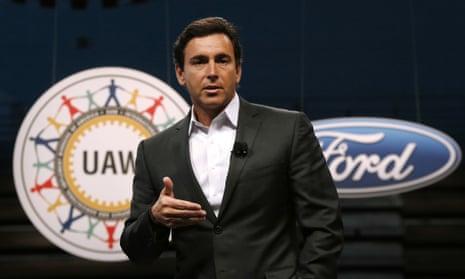The robot car wars moved up a gear on Tuesday when Ford announced it would produce a fleet of driverless cars for ride-sharing services, such as Uber and Lyft, by 2021.
Mark Fields, Ford’s president and chief executive, said the next decade would be “defined by automation of the automobile” and the switch to driverless travel would affect society as much as the introduction of the assembly line, allowing mass-produced cars, did a century ago.
“We’re dedicated to putting on the road an autonomous vehicle that can improve safety and solve social and environmental challenges for millions of people – not just those who can afford luxury vehicles,” he said in a speech to workers in Silicon Valley.
Ford, which last month warned it was considering closing factories in the UK due to concerns about the effects of Brexit, said it would double the size of its Silicon Valley testing and research facility to turn Fields’ vision into reality.
The company said its new cars would be fully automated – with no steering wheels or pedals – rather than producing a partly autonomous model like those made by Tesla, Audi and BMW that can self-steer and control speed via sensors on highways. In an effort to catch up with Apple and Alphabet (Google’s parent company), which have both been working on the development of driverless cars for some years, Ford announced a series of investments in automation and sensor technology.
“Ford has been developing and testing autonomous vehicles for more than 10 years,” Raj Nair, Ford’s chief technical officer, said. “We have a strategic advantage because of our ability to combine the software and sensing technology with the sophisticated engineering necessary to manufacture high-quality vehicles. That is what it takes to make autonomous vehicles a reality for millions of people around the world.”
The 113-year-old company said the new cars, which will be designed at its research facility in Palo Alto, California, were being “specifically designed for commercial mobility services, such as ride-sharing and ride-hailing, and will be available in high volumes”. The company did not state if it planned to go into partnership with Uber or Lyft, as other carmakers have, but said it was exploring all options.
It expects to have 30 test self-driving Fusion Hybrid cars on the road in California, Arizona and Michigan this year, and 90 next year.
The company, which opened its Palo Alto research facility just last year, said it would double the size of its development team to 260 by the end of 2017.
“Our goal was to become a member of the community,” Ken Washington, Ford’s head of research and advanced engineering, said. “Today, we are actively working with more than 40 startups, and have developed a strong collaboration with many incubators, allowing us to accelerate development of technologies and services.”

Comments (…)
Sign in or create your Guardian account to join the discussion